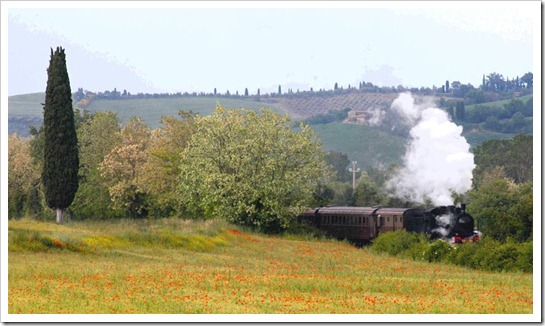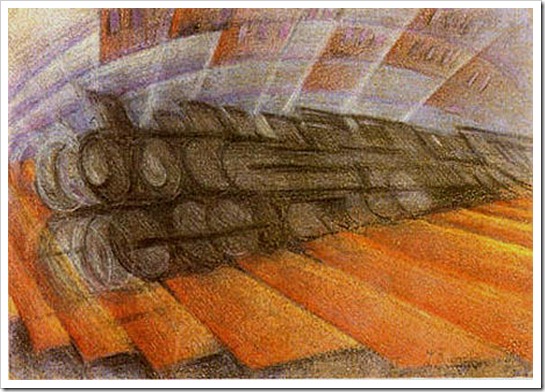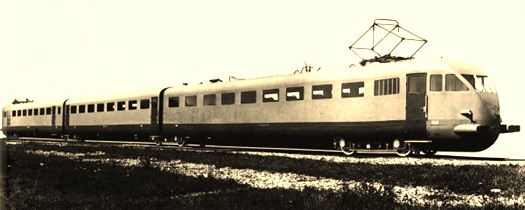A Brief History of the Italian Railways Posted by Serena on Apr 29, 2014 in Uncategorized
There are many ways to explore the beauties of the Italian landscape, but surely one of the most romantic and evocative must be by steam train.
I’ve just read a brief history of the Italian railways, which I raced through in un batter d’occhio (in the blink of an eye) as I was totally fascinated by it. Here are a few notes that I garnered.
The first Italian railway was the Napoli – Portici line. Running for a grand total of 7.25 km, it was inaugurated on the 3rd of October 1839 by the Borbonic king Ferdinando II. At that time Napoli was the capital of the Regno delle Due Sicilie, and the Italian Peninsula was still divided into several different countries. Only twenty two years later, when Italy was finally unified in 1861, there were a total of 2,370 km of railway throughout the country, the majority of which were in the north-western region of Piedmont.
After the unification of Italy, the newly formed government decided that the creation of a railway network, which connected the main cities and the north of Italy with the south, would be fundamental to the effective unification of the country, both geographically and economically. The majority of these lines would run through coastal areas. This goal was reached by the end of 1875, with a total of 9,077 km of railways. At this point the government then decided to move towards creating a network which would link together the minor towns, running further inland through hills and mountains. These new lines would also serve a strategic purpose as they would be more protected from possible enemy attacks coming from the sea.
In an era in which the locomotive was the only mechanical means of land transport, the train was viewed as a symbol of modernity and progress by artists such as Boccioni and Russolo who were part of the Italian Futurism movement at the beginning of the Twentieth century. The development of the rail network was generally welcomed by the populations of small, formerly isolated towns, as illustrated in the traditional folk song La Strada Ferrata (The Iron Road), written for the inauguration of the railway station in Trieste. (You can find the lyrics translated into English HERE)
It’s interesting to note that by 1939 Italy had the highest percentage of electrified railway in the world. This was due to the fact that the peninsula lacks fossil fuels but thanks to its mountainous nature does have numerous water courses. These were exploited to generate the hydroelectric energy needed to power the locomotives. The use of electricity was not only more cost effective than importing coal, but it also provided more power, and hence velocity, to the trains. In fact, on the 20th of July 1939 the ETR.212 electric train established the world speed record for a commercial train.
The supremacy of the train was dealt a severe blow by the heavy bombardments of WWII, and this, combined with the rapid post war development of road transport, set in motion a gradual but unstoppable decline in the railway system. Today in Italy there are more than 6,000 km of disused railway track. Fortunately there are groups of enthusiasts throughout Italy who are trying to restore the old forgotten lines, with their panoramic views, to their former glory, transforming them into tourist attractions. One example of this small renaissance is the Treno Natura, a steam train which runs in a leisurely manner between Siena and Monte Antico, crossing on its way the beautiful Val d’Orcia. Here’s a link to the official web site, detailing this year’s timetable.
Allora, after writing this post I’m determined to take Geoff for a ride on the little local train that still runs between Aulla (a few km south of us) and Lucca passing through the beautiful landscapes of the Garfagnana and the Alpi Apuane, and halting at small gems such as Equi terme, Barga and Bagni di Lucca.

Build vocabulary, practice pronunciation, and more with Transparent Language Online. Available anytime, anywhere, on any device.







Comments:
Mike Mazzaschi:
Nice story, thanks. You can walk or ride a bike through one of the rail tunnels that completed the circumnavigation of Italy. Going from Framura to Levante, it was replaced after WWII, and is now recreational. Info on the sad story of American soldiers executed for trying to blow it up, Ameglia Executions.
Serena:
@Mike Mazzaschi Salve Mike,
thanks for your contribution. We went to Ameglia a couple of weeks ago because it’s not far from where we live, and we have a friend who lives there. I didn’t know anything about the Ameglia Executions, but I’m looking it up on the internet right now. Very sad. I’ll might follow it up with an article.
Saluti da Serena
William Auge:
Salve Serena, grazie per la breve storia della ferravia. Forse sono stanco di lavorare per una ferravia, ma penso il treno e’ la nostra migliore forma di transporto.
ciao, Bill
Serena:
@William Auge Salve Bill,
mentre scrivevamo quest’aticolo ti abbiamo pensato 😉
saluti da Serena